Trip to Sognefjorden
Part three - Jotumheim, up on the high mountains
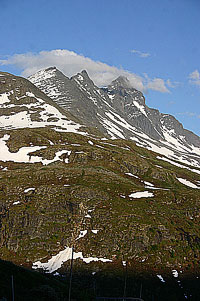
"Jötunheimr (often anglicized Jotunheim) is the world of the giants (two types: rock and frost, collectively called Jotuns) in the Norse Mythology. From there they menace the humans in Midgard and the gods in Asgard (from whom they are separated by the river Iving). Gastropnir, home of Menglad, and Þrymheimr, home of Þjazi, were both located in Jotunheim, which was ruled by King Thrym. Glæsisvellir was a location in Jotunheim, where lived the giant Gudmund, father of Höfund. The Norse would sometimes make oaths "By the gloom of Jötunheimr.""
(Wikipedia.org)

"Jotunheim is one of the nine worlds, the homeland of the frost giants and rock giants. Situated in Midgard, on the middle level of the Norse universe, Jotunheim is separated from Asgard by the river Iving, which never freezes over. It lies in the snowy regions on the outermost shores of the ocean. Mimir's well of wisdom is in Jotunheim, beneath the Midgard root of the ash tree Yggdrasil. Jotunheim is ruled by Thrym ("uproar"), the feared king of the frost giants. The stronghold of Utgard, the chief city of Jotunheim and the abode of the giants, is ruled by the giant Utgard-Loki. Other strongholds include Gastropnir, home of the giantess Menglad, and Thrymheim ("house of uproar"), mountain stronghold of the giant Thiazi".
(Encyclopedia Mythica)

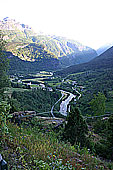






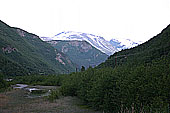
This is the top of the Scandinavia. Here are the highest peaks of Scandinavia in a rugged but still beautyful area where still closet to the mid summer you will find snow over six meters deep!! During the visit, the clock was close to mid night in the end of June but still it was allmost as bright as in midday, though the low light casted its longer shadow and added even more drama to the scenery. The summit is on close to 1500 meters over the sea level and it is the highest point for any public road here in Scandinavia, Thinking of the fact that the road starts its climb at the fjord the grade of 10% over more than 20 kilometres is not just impressive, it is even some degree even more scenic than the famous Trollstigen.
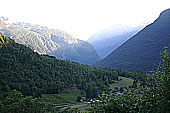
Down in the valley is a village which disappears pretty fast as the road twist up, up and up. I counted on 20 hairpin corners before i lost the count. Before the the first high peaks appears at Sognefjell, there are a few elderly small cabins, where the wood exteriour has been weathered to gray by the harse elements of rain, wind, snow and the bitter cold winters.







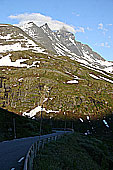
Last time I was here was in August of 1994 and below the snow you could see the greenish tint of ice. In other words there is a bits of glaciers here and it added an extra color to the scenes. But under the thick snow it is very beautyful. At this hour, close to mid night it becomes appearent that you are just lucky to be visitor here. The distances are vast and the sheer size of the mountains it is so easy to underestimate the distances. The weather was much cooler than down at the fjord so it is easy to get chilled to the bones. Here we people will be reminded of how small we are and the endless of the time. Though we can live some 70-90 years, still these mountains have been here before us and hopefully be there after generations of has past. We don't own this planet, we are just visitors.
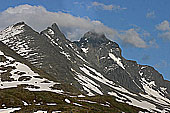
It is the the third time I have been here and everytime I come across some X-skiing national teams here. I guess the thin air and the large amount of snow makes this x-skiers paradise during the summers.
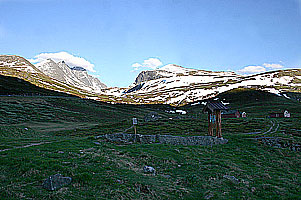







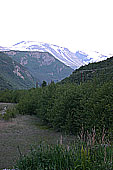
The rivaling peaks
Galdhöpiggen
Galdhöpiggen is the highest mountain in Norway, Scandinavia and Northern Europe, at 2,469 m (8,100 ft) above sea level. It is located within the municipality of Lom, (in Oppland) in the Jotunheimen mountain area. Galdhøpiggen means "the peak (piggen) of the mountain Galdhø." The first element in the name of the mountain is gald m "steep mountain road", the last element is hø f "(big and) round mountain."Glittertind
Glittertind had earlier been a challenger for the title as the highest mountain in Norway, as measurements showed Glittertind including the glacier was slightly higher than Galdhøpiggen (2,469 m above sea level). The glacier has, however, shrunk in recent years, and the dispute has been settled in Galdhøpiggen's favour. The summit of Glittertind was reached for the first time in 1841 by Harald Nicolai Storm Wergeland and Hans Sletten.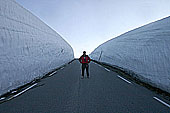
Norwegians has a habit of "gå på tur", to wander off, whether it on hiking on foot or on skies it does not matter. In fact many of the famous Norwegian writers have done that too here at the




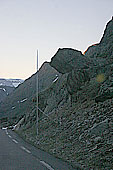
After a while the summit is reached and from here the road will be down grade. Compared to the grade from the fjord, here it has just a few hairpin curves and slowly we are back beow the tree level and facing up to the barren lands dotted with snow. It is sudden realisation to understand how high the road has taken us. The road follows a mountain brook that grows in to a river in the deep valley that eventually broadens up to farmland framed by the mountain walls.


I am not sure but there was this high mountain overshadowing the surrounding mountains. Knowing it has to be near the highway and that it does have a special shape, thid could be the highest mountain in Scandinavia, Galdhöpiggen (alt. 2469 metres over the sea level).
Soon we reach the last of the high mountains close to the river Otta, with a town named after the mountain, Lom.
(part one) (part two) (part four)
